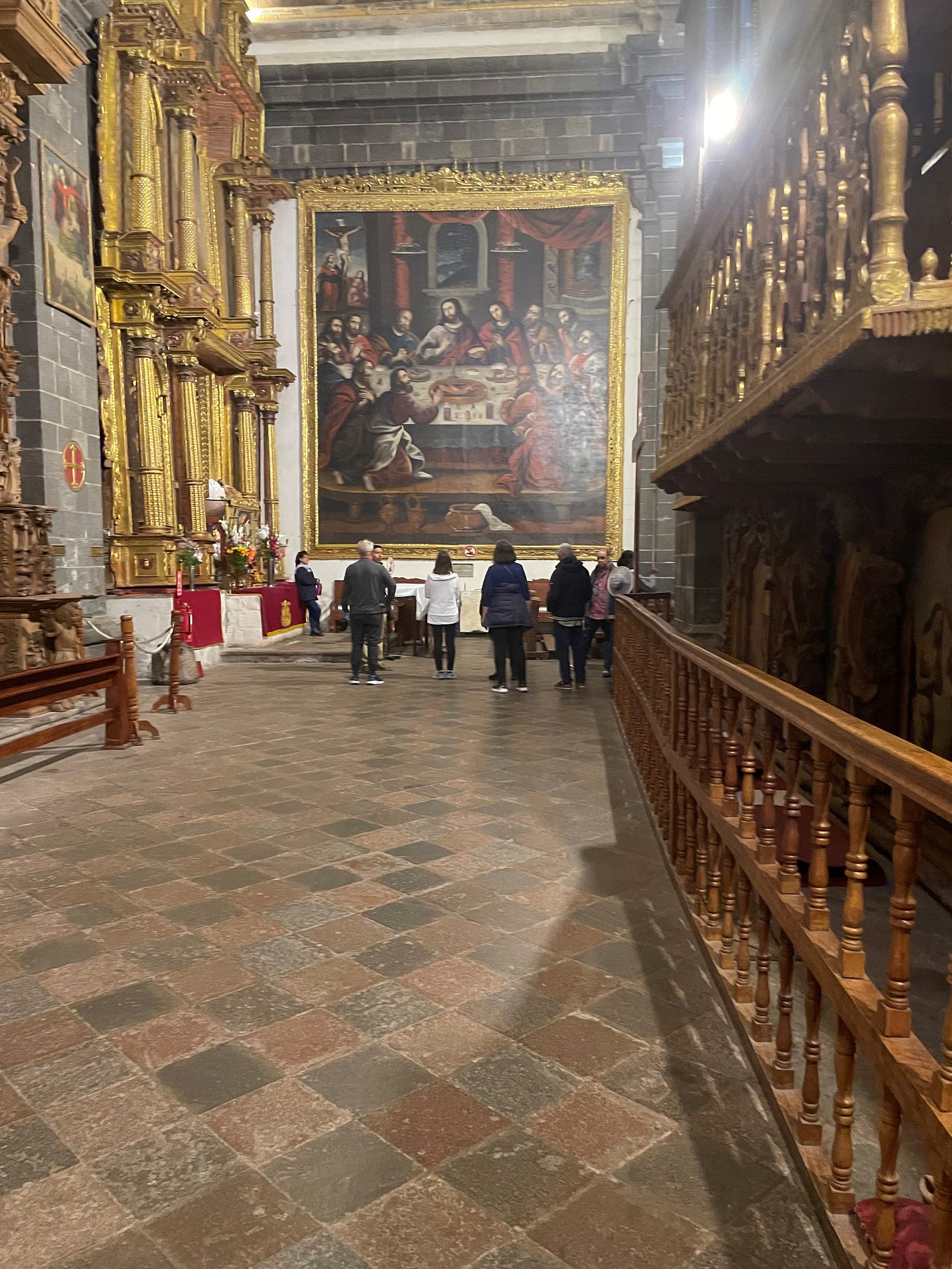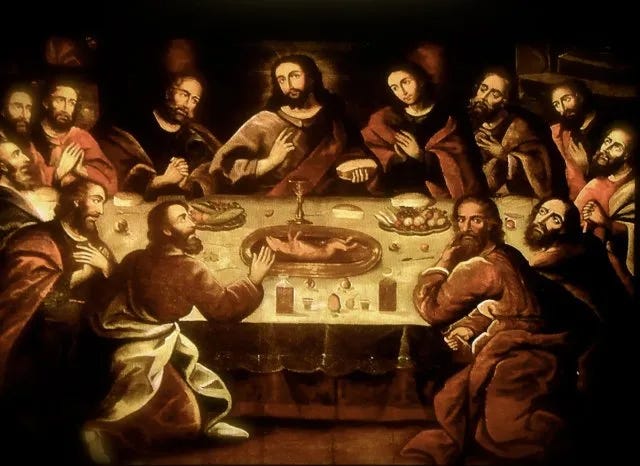Excursion to Machu Picchu - Part 1
Francisco Pizarro, the Conquest of Peru and the hiding of Machu Picchu
Preface
In December 2023 we went on a cruise out of Miami to the Western Caribbean and Central America, through the Panama Canal and down the west coast of South America to Ecuador, ending up in Lima, Peru.
The cruise company, Oceania, offered a 3 day post-cruise excursion to Machu Picchu.
This piece is the first of three essays or reflections on aspects of that excursion. It is not intended as a travelogue but more as a collection of observations and some of the thoughts those observations brought to mind.
Francisco Pizarro, the Conquest of Peru and the hiding of Machu Picchu
In Cuzco, in the Peruvian Andes, 11,152 feet above sea level, is the Cuzco Cathedral Basilica known as the Cathedral Basilica of the Virgin Assumption. The Cathedral was built between 1559 and 1654 and contains elements of Renaissance, Baroque and Gothic styles. It was built was built with stone blocks brought from the fortress of Sacsayhuaman.
Within there is a painting of the Last Supper in the. It is by Marcos Zapata and was painted in the eighteenth century.
Marcos Zapata was a Peruvian Quechua painter and member of the Cusco (Cusqueña) School, a tradition of teaching European art techniques in the Americas which the Spanish used as a method to convert the native Incas to Catholicism.
Several painters at this time incorporated local indigenous elements in religious works, but it is surprising that this piece of art was tolerated by the Catholic Church, especially during the time of the Inquisition.
Zapata’s painting contains, as do other works in the Basilica, a number of local Quechua symbols which distinguish it from traditional European depictions of the Last Supper. The central platter on the table contains not the sacrament as bread but cuy – the Peruvian delicacy of guinea pig. Jesus and his disciples are drinking chicha, a traditional Peruvian corn drink
But the most controversial depiction is that of the only figure besides Christ who is looking at the viewer. It is Judas, seated at the bottom right, his hand below the table clutching a money pouch. But that is not what is so controversial. The face of Judas is in fact the face of the Conquistador and conqueror of Peru, Francisco Pizarro.
Pizarro, born in Spain in 1478, chose to pursue his fortune in the New World. He accompanied Vasco Núñez de Balboa in his crossing of the Isthmus of Panama, where they became the first Europeans to see the Pacific Ocean from the Americas. He served as mayor of the newly founded Panama City for a few years and undertook two failed expeditions to Peru. In 1529, Pizarro obtained permission from the Spanish crown to lead a campaign to conquer Peru and went on his third, and successful, expedition. Earlier expeditions had limited if any success.
Pizarro acted under the authority of the Capitulación de Toledo on 6 July 1529, a license document that authorized him to proceed with the conquest of Peru. He was officially named the Governor, Captain general, Adelantado and Alguacil Mayor, of New Castile for the distance of 200 leagues along the newly discovered coast and invested with all authority and prerogatives, leaving his associates in secondary positions.
He finally reached Panama and left for Peru on 27 December 1530. Many of the men accompanying him were of dubious reputation. They were convicted criminals, paroled on the understanding that if they went to the New World, they could never return. What they made of their opportunities in South America was up to them. And many of them were ruthless and desperate characters.
The Inca themselves had been having difficulties before the arrival of the Spanish. Following the defeat of his brother, Huáscar, in the Inca Civil War, Atahualpa, the Inca ruler, had been resting in the Sierra of northern Peru, near Cajamarca, in the nearby thermal baths known today as the Inca Baths.
On 15 November 1532, Pizarro with a force of just 110-foot soldiers, 67 cavalry, three arquebuses and two falconets, arrived at Cajamarca. He sent his brother Hernando Pizarro and de Soto to meet with Atahualpa in his camp. Atahualpa agreed to meet Pizarro in his Cajamarca plaza fortress the next day.
Fray Vincente de Valverde and native interpreter Felipillo approached Atahualpa in Cajamarca's central plaza. After the Dominican friar expounded the "true faith" and the need to pay tribute to the Emperor Charles V, Atahualpa replied, "I will be no man's tributary" His complacency, because fewer than 200 Spanish remained, as opposed to his 50,000-man army, of which 6,000 accompanied him to Cajamarca, sealed his fate and that of the Inca empire.
Atahualpa's refusal led Pizarro and his force to attack the Inca army in what became the Battle of Cajamarca on 16 November 1532. The Spanish were successful. Pizarro executed Atahualpa's 12-man honor guard and took the Inca captive at the so-called Ransom Room.
Atahualpa promised to pay a ransom of a room full of gold and two of silver. However, Atahualpa was placed on trial. He was convicted of 12 charges, including killing his brother and plotting against Pizarro and his forces. He was executed by garrote on 29 August 1533. Francisco Pizarro and de Soto were opposed to Atahualpa's execution, but Francisco consented to the trial due to the "great agitation among the soldiers".
De Soto was on a reconnaissance mission the day of the trial and execution and upon his return expressed his dismay, stating, "he should have been taken to Castile and judged by the emperor." King Charles later wrote to Pizarro: "We have been displeased by the death of Atahualpa, since he was a monarch and particularly as it was done in the name of justice."
Pizarro advanced with his army of 500 Spaniards toward Cuzco, the Inca capital, accompanied by Chalcuchimac, one of the leading Inca generals of the north and a supporter of Atahualpa. He was subsequently burned at the stake.
During the exploration of Cuzco, Pizarro was impressed and through his officers wrote back to King Charles I of Spain, saying: "This city is the greatest and the finest ever seen in this country or anywhere in the Indies... We can assure your Majesty that it is so beautiful and has such fine buildings that it would be remarkable even in Spain."
The Spanish sealed the conquest of Peru by entering Cuzco on 15 November 1533. Jauja, in the fertile Mantaro Valley, was established as Peru's provisional capital in April 1534, but it was high up in the mountains and too distant from the sea to serve as the capital. Pizarro founded the city of Lima on Peru's central coast on 6 January 1535.
The Inca unsuccessfully tried to recapture Cuzco in 1536. Despite winning the majority of the battles, the inability of the Incan forces to overwhelm Cuzco's fortifications, manned as they were by only 200 fighting men armed with gunpowder weapons, signalled the definitive victory of Spanish forces.
Atahualpa's wife, 10-year-old Cuxirimay Ocllo Yupanqui, was with Atahualpa's army in Cajamarca and had stayed with him while he was imprisoned. Following his execution, she was taken to Cuzco and given the name Dona Angelina. By 1538, it was known she had borne Pizarro two sons, Juan and Francisco.
Pizarro was assassinated in Lima on 26 June 1541.
The Hiding of Machu Picchu
But the Spanish never found the town of Machu Picchu, situated high in the Andes. To prevent a probable looting of the town by the Spanish, the Incas burned the forest surrounding the town so that the re-growth would cover up access trails. To further preserve the secret of its location the Incas abandoned the site about 100 years after its construction. The town remained a secret although it was inhabited. But it was unknown to outsiders for nearly 400 years until Hiram Bingham's visit in 1911.






Such a fascinating account, thank you. We visited Machu Pichu in the early 1970's before it became so popular - a truly magical experience. We had an American tourism journalist with us, who said she would not write about it, as she didn't want it overrun with hoards of tourists, it was such a sacred place! I look forward to the next instalment....